Caring for Western Leather Goods
by Bob Brooke
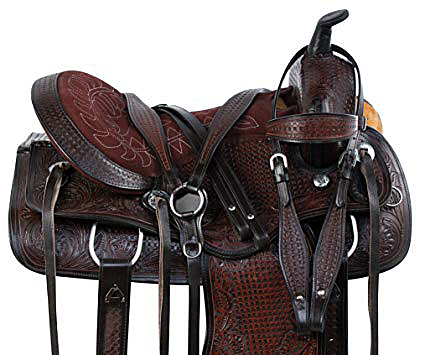 Leather
is timeless. Many western antiques were made of it in whole or part.
But just because leather is famously durable doesnít mean that it
shouldnít be given some TLC. To ensure that leather goods have a
long life, itís vital to regularly clean them and perform some light
maintenance. Leather
is timeless. Many western antiques were made of it in whole or part.
But just because leather is famously durable doesnít mean that it
shouldnít be given some TLC. To ensure that leather goods have a
long life, itís vital to regularly clean them and perform some light
maintenance.
More than anything, itís important to keep your leather clean. Try
to brush it down with a damp cloth at least once a week. Use a damp
cloth. Start by brushing off any dirt of grime from the leather with
your hand, then switch to a damp cloth. Do not use any soaps or
cleansers. Then let the leather dry slowly.
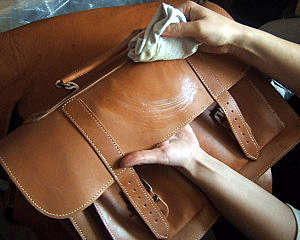 Clean
stains as soon as possible. Remove them as soon as you spot them to
prevent extreme discoloration. Clean
stains as soon as possible. Remove them as soon as you spot them to
prevent extreme discoloration.
For minor stains, use a mild solution of three parts ivory dish soap
to one part distilled water for minor stains. However, leather
corrects itself over time, so even marks that seem major will
eventually contribute to the overall patina.
For faded leather, use a conditioner, as it will rehydrate and
reintroduce oils into the leather. If the leather has stains, apply
conditioner not only to the stains, but to the entire piece.
Conditioning leather will darken it, so consider that before doing
it. Apply the conditioner, let it sit for a few minutes, then wipe
off the excess.
Handle With Clean Hands
An important thing to keep in mind is that the natural oils from
human skin will gradually discolor leather over time, so itís a
smart idea to keep your hands clean when handling your most precious
products. Body oils encourage the further aging of leather, so itís
important to keep contact with them at a minimum. Wearing white
cotton gloves while handling western leather antiques may also help.
Wipe Away Dust
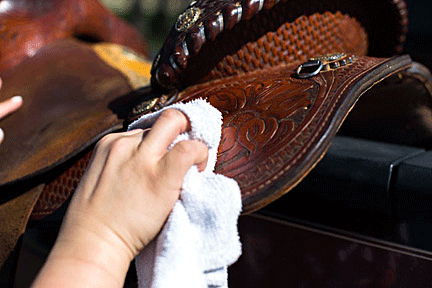 Aside
from wiping down your leather goods with plain, white cloths, itís
also crucial to regularly dust them to prevent irritation. Aside
from wiping down your leather goods with plain, white cloths, itís
also crucial to regularly dust them to prevent irritation.
Dust has a way of drying out the surface of a leather, so itís a
good idea to periodically dust leather products. Not only will this
protect the oils in the leather, but it will help to create
longevity.
Just like your skin, leather needs to breathe, so after you have
finished dusting your jacket, leave it to air out before storing it
again. Leather is meant to change as it gets older, and itís through
this aging that its true value becomes apparent.
So instead of getting upset over minor stains, scratches or
blemishes, think of a leatherís patina as a reflection of the life
itís led.
Cleaning and Care of a Leather
Saddle
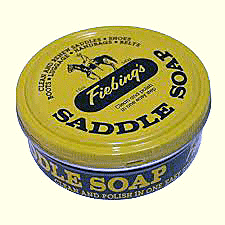 The
longevity of any leather saddle is directly related to the care and
maintenance it receives. How often you need to clean your saddle
depends on the type and frequency of your riding. If you use your
saddle in sporting events and competitions then youíll need to clean
your saddle more often than someone who simply goes for weekend
pleasure rides. If you expose your saddle to dirt, mud, and sweat,
youíll need to clean your saddle more often. The
longevity of any leather saddle is directly related to the care and
maintenance it receives. How often you need to clean your saddle
depends on the type and frequency of your riding. If you use your
saddle in sporting events and competitions then youíll need to clean
your saddle more often than someone who simply goes for weekend
pleasure rides. If you expose your saddle to dirt, mud, and sweat,
youíll need to clean your saddle more often.
To clean your saddle, take a damp sponge and apply a mild leather
cleaner or saddle soap. Work the soap into a lather and apply it to
your saddle in small circular motions. Cover the entire leather area
of your saddle carefully, avoiding suede or rough-out areas. Make
sure you get the undersides of the leather, as well as between
flaps. You may need to rinse and reapply saddle soap to your sponge
several times during this process, depending on how soiled the
saddle is.
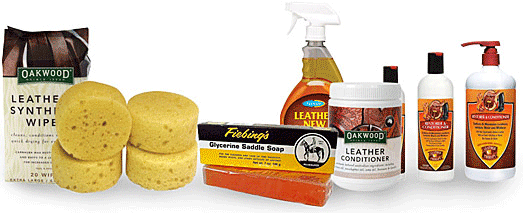
Next, dampen a towel and wipe your saddle down to remove any excess soap
residue. Itís import to make sure you remove all residue so that it
doesnít damage the leather over time. Keep in mind that residue left in
folds and crevices can attract dirt and grime later. Use a cotton swab
to remove soap residue from those hard-to-get-to areas.
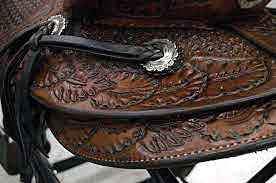 Next,
apply a non-detergent leather conditioner sparingly and according to its
directions. Be careful not to over apply leather conditioners. Applying
too much conditioner to your saddle can cause the conditioner to
penetrate through to your saddleís padding or the tree, leading to
damage over time. Next,
apply a non-detergent leather conditioner sparingly and according to its
directions. Be careful not to over apply leather conditioners. Applying
too much conditioner to your saddle can cause the conditioner to
penetrate through to your saddleís padding or the tree, leading to
damage over time.
Finally, youíll want to clean the metal fittings on your saddle and wipe
with a dry cloth to remove any residual cleaner. If you have a western
show saddle, at this point you may also want to polish any silver trim
with a quality silver polish, being careful not to get any on the
leather. NEW:
Watch a video on how to restore cowboy boots.
<
Back to Caring for Your Collections
Archives
Next Article
>
|
